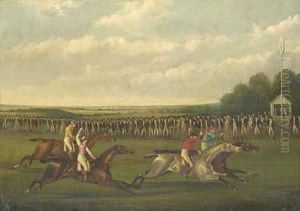Henry Thomas Sen Alken Paintings
Henry Thomas Alken was a British painter and engraver known predominantly for his sporting and hunting scenes. Born on October 12, 1785, in Soho, London, he was the son of the Danish miniaturist and engraver Samuel Alken. He received his early training from his father, which established his foundation in art. Alken's work focused on capturing the British sporting life by depicting various aspects of hunting, fishing, coaching, racing, and other country pursuits that were central to British leisure culture during the 19th century.
Alken began his career primarily as a miniaturist, but by 1816 he had started to make a name for himself as a skilled painter of sporting subjects. He published his first collection of prints, 'The Beauties & Defects in the Figure of the Horse', comparatively delineated, in that year. Alken's ability to depict movement and his attention to detail in the portrayal of horses and country life quickly attracted the attention of wealthy patrons and sports enthusiasts.
Throughout his career, Alken produced a great number of artworks including oil paintings, watercolors, and engravings. His images were often published in the form of prints or illustrated books, which were very popular. Some of his well-known works include 'The National Sports of Great Britain', a series of 50 color-plate engravings published in 1821, and 'The Art and Practice of Etching', published in 1849, which included his own writings on the subject of printmaking.
Alken's work reflects the transformation and enthusiasm for rural sports amidst the social and economic changes of the Industrial Revolution. His illustrations not only served as documentation of these activities but also provided a form of entertainment and nostalgia for a way of life that was idealized by many during the period. Despite his prolific output and the popularity of his work during his lifetime, Alken struggled financially and was known to have lived a rather bohemian lifestyle.
Henry Thomas Alken passed away on April 7, 1851. His legacy continues as his works remain a valuable record of English country life and sporting activities of the early 19th century. They are collected and admired for their vibrant energy, technical skill, and historical value, providing insight into the era's leisure and social practices.
